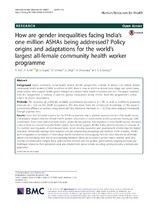| dc.contributor.author | Ved, R. | |
| dc.contributor.author | Scott, K. | |
| dc.contributor.author | Gupta, G. | |
| dc.contributor.author | Ummer, O. | |
| dc.contributor.author | Singh, S. | |
| dc.contributor.author | Srivastava, A. | |
| dc.contributor.author | George, A. S. | |
| dc.date.accessioned | 2020-02-20T11:57:22Z | |
| dc.date.available | 2020-02-20T11:57:22Z | |
| dc.date.issued | 2019 | |
| dc.identifier.citation | Ved, R., Scott, K., Gupta, G., Ummer, O., Singh, S., Srivastava, A., & George, A. S. (2019). How are gender inequalities facing india's one million ASHAs being addressed? policy origins and adaptations for the world's largest all-female community health worker programme. Human Resources for Health, 17(1) doi:10.1186/s12960-018-0338-0 | en_US |
| dc.identifier.issn | DOI: 10.1186/s12960-018-0338-0 | |
| dc.identifier.uri | http://hdl.handle.net/10566/5192 | |
| dc.description.abstract | Background: India’s accredited social health activist (ASHA) programme consists of almost one million female community health workers (CHWs). Launched in 2005, there is now an ASHA in almost every village and across many urban centres who support health system linkages and provide basic health education and care. This paper examines how the programme is seeking to address gender inequalities facing ASHAs, from the programme's policy origins to recent adaptations.
Methods: We reviewed all publically available government documents (n = 96) as well as published academic literature (n = 122) on the ASHA programme. We also drew from the embedded knowledge of this paper’s government-affiliated co-authors, triangulated with key informant interviews (n = 12). Data were analysed thematically through a gender lens.
Results: Given that the initial impetus for the ASHA programme was to address reproductive and child health issues, policymakers viewed volunteer female health workers embedded in communities as best positioned to engage with beneficiaries. From these instrumentalist origins, where the programme was designed to meet health system demands, policy evolved to consider how the health system could better support ASHAs. Policy reforms included an increase in the number and regularity of incentivized tasks, social security measures, and government scholarships for higher education. Residential trainings were initiated to build empowering knowledge and facilitate ASHA solidarity. ASHAs were designated as secretaries of their village health committees, encouraging them to move beyond an all-female sphere and increasing their role in accountability initiatives. Measures to address gender based violence were also recently recommended. Despite these well-intended reforms and the positive gains realized, ongoing tensions and challenges related to their gendered social and employment status remain, requiring continued policy attention and adaptation. | en_US |
| dc.language.iso | en | en_US |
| dc.publisher | Human Resources for Health | en_US |
| dc.subject | Gender | en_US |
| dc.subject | India | en_US |
| dc.subject | Policy analysis, | en_US |
| dc.subject | Human resources | en_US |
| dc.subject | Community health | en_US |
| dc.title | How are gender inequalities facing India’s one million ASHAs being addressed? Policy origins and adaptations for the world’s largest all-female community health worker programme | en_US |
| dc.type | Article | en_US |

